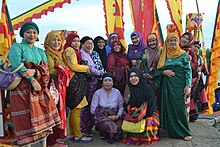
Back شعب ماجوينداناو Arabic Maguindanaos Catalan Maguindanaon German Suku Maguindanao ID マギンダナオ族 Japanese Магинданао Kazakh 마긴다나오족 Korean Magindanaji Latvian/Lettish Магинданао (народ) Russian Магінданао (народ) Ukrainian
Magindanawn مڬیندنون | |
|---|---|
 Maguindanaon women at S.K Festival. | |
| Total population | |
| 2,021,099 - 3,219,000 (2020 census)[1] (1.9% of the Philippine population) | |
| Regions with significant populations | |
(Bangsamoro, Soccsksargen, Zamboanga Peninsula, Davao Region, Manila, Cebu) | |
| Maguindanao del Norte and Maguindanao del Sur | 1,101,885[2] |
| Sultan Kudarat | 243,445[3] |
| North Cotabato | 214,015[4] |
| South Cotabato | 41,721[5] |
| Sarangani | 41,516[6] |
| Zamboanga del Sur | 41,255[7] |
| General Santos City | 40,073[8] |
| Metro Manila | 38,861[9] |
| Zamboanga Sibugay | 12,910[10] |
| Bukidnon | 10,709[11] |
| Davao City | 8,258[12] |
| Zamboanga del Norte | 4,030[13] |
| Rizal | 3,168[14] |
| Cavite | 2,816[15] |
| Davao del Norte | 2,658[16] |
| Languages | |
| Native Maguindanaon Also Filipino • English | |
| Religion | |
| Sunni Islam | |
| Related ethnic groups | |
| Maranao, Iranun, Kalagan, Lumad, Sama-Bajau, other Moro peoples, Visayans, other Filipinos, Malay people other Austronesian peoples | |
The Maguindanaon people are an Austronesian ethnic group from the Philippines. The Maguindanaon are part of wider political identity of Muslims known as Moro, who constitute the third largest ethnic group of Mindanao, Sulu and Palawan. The Maguindanaons constitute the ninth largest Filipino ethnic group and are known for being distinguished in the realm of visual art. They have been renowned as metalworkers, producing the wavy-bladed keris ceremonial swords and other weapons, as well as gongs. The Maguindanaons historically had an independent sultanate known as the Sultanate of Maguindanao which comprises modern day Maguindanao del Norte, Maguindanao del Sur, Zamboanga Peninsula, Davao Region and Soccsksargen. The name "Maguindanao/Magindanaw" itself was corrupted by Spanish sources into "Mindanao", which became the name for the entire island of Mindanao.[17]
- ^ "Ethnicity in the Philippines (2020 Census of Population and Housing)". Philippine Statistics Authority. Retrieved July 4, 2023.
- ^ "2020 Census of Population and Housing". Philippine Statistics Authority. 2020.
- ^ "2020 Census of Population and Housing". Philippine Statistics Authority. 2020.
- ^ "2020 Census of Population and Housing". Philippine Statistics Authority. 2020.
- ^ "2020 Census of Population and Housing". Philippine Statistics Authority. 2020.
- ^ "2020 Census of Population and Housing". Philippine Statistics Authority. 2020.
- ^ "2010 Census of Population and Housing". Philippine Statistics Authority. 2020.
- ^ "2020 Census of Population and Housing". Philippine Statistics Authority. 2020.
- ^ "2020 Census of Population and Housing". Philippine Statistics Authority. 2020.
- ^ "2020 Census of Population and Housing". Philippine Statistics Authority. 2020.
- ^ "2020 Census of Population and Housing". Philippine Statistics Authority. 2020.
- ^ "2020 Census of Population and Housing". Philippine Statistics Authority. 2020.
- ^ "2020 Census of Population and Housing". Philippine Statistics Authority. 2020.
- ^ "2020 Census of Population and Housing". Philippine Statistics Authority. 2020.
- ^ "2020 Census of Population and Housing". Philippine Statistics Authority. 2020.
- ^ "2020 Census of Population and Housing". Philippine Statistics Authority. 2020.
- ^ Campbell, Gwyn (2018). Bondage and the Environment in the Indian Ocean World. Springer. p. 84. ISBN 9783319700281.
© MMXXIII Rich X Search. We shall prevail. All rights reserved. Rich X Search